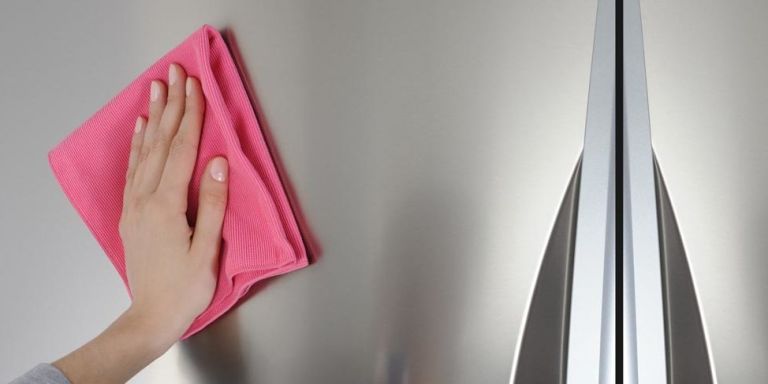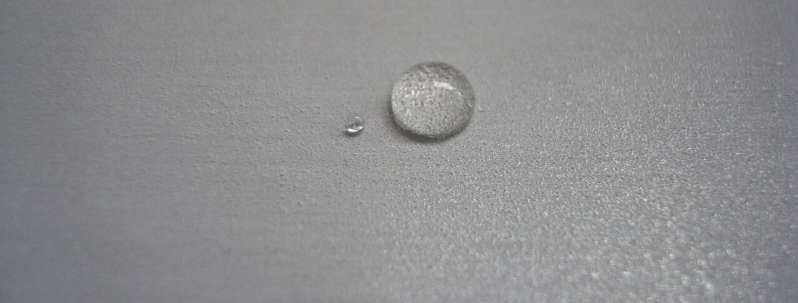Anyone who has any stainless steel products in their home knows of the beauty of a clean and shiny fridge or work surface. They also know how easily fingerprints can make their kitchens look unattractive.
Worse still, is that the grease film even attacks the stainless steel, actually damaging the surface. And the only way to remove the fingerprints is with chemical cleaners and a large amount of polishing.

But now researchers from the Fraunhofer Institute for Microstructure of Materials and Systems IMWS in Halle, Germany are on the cusp of creating a new nanocoating that uses its water and oil repellent properties to prevent unsightly fingerprints on stainless steel surfaces.
By applying nanomaterials into a thin layer on kitchen appliances and worktops, the coating specialists have found a way to both protect the metal and prevent greasy smears.
The nanocoating layer works in two different ways, as the online scientific journal Phys.org explains, “When the particles integrated in the coating settle on the surface of the stainless steel, the surface becomes rougher and its surface area increases. When a finger comes into contact with the refrigerator door, it only touches the raised points on the surface and the grease on the fingertip never reaches the ‘valleys’ of the stainless steel surface. This means the surface area which actually comes into contact with the grease is kept very small.”
The second way involves how the nanocoating reflects light, as reported. “In addition, the refractive index of the coating has been adjusted so that it matches that of the skin's natural oil content. This means light is reflected by the coated stainless steel surface in about the same manner as by a surface that has been touched by sticky fingers. As a result, the fingerprints are hardly noticeable.”

The development of the coating is being handled by nanotechnology specialists at FEW Chemicals GmbH, while their colleagues at the Fraunhofer team are focusing on how the layers work to prevent smearing.
As Dr Jessica Klehm, a research associate at Fraunhofer IMWS, notes, “We're investigating the layers created using not only optical microscopy, but also scanning electron microscopy and atomic force microscopy. We look at how large the individual particles in the coating system are and whether or not they are distributed homogenously. The effect of the additives used is another focus of our analysis.”
This analysis is not taken lightly, as Dr Klehm explains, “Such questions are extremely important in the assessment of the quality of the coating. For example, if the nanoparticles aggregate to form larger particles, the coating may lose its transparency as a result. On the other hand, if the particles are too small, the surface remains too smooth, so that the grease film can adhere to it over larger areas in spite of the coating.”
Studying such small coatings and the way their nanoscale raw material operates is no easy task. Initial analysis of the coating by optical microscopy required sample sizes of about 70 micrometres (about as thick as a human hair). Later examination under a transmission electron microscope needs samples one thousand times thinner, measuring about 70 nanometres.
“We can't cut the samples to size using a saw, as that would destroy the coating. Therefore, we embed the samples in resin and then grind them down to the desired thickness,” says Dr Klehm.
To further help in finding which concentration and size of nanomaterials work best in the coating, the researchers are devising an automatic testing machine, which will be able to scientifically evaluate which coating samples are most able to hide fingerprints without the need for human hand and eye.

As the Fraunhofer press release describes, “The machine dips a stamp in a solution whose composition resembles that of the oily film on human skin. Working automatically and with constantly identical force and duration, this stamp then presses on the coated surface in order to leave behind ‘fingerprints’.”
The machine then analyses how much of the solution remains on the surface, to derive a percentage value to indicate the effectiveness of the anti-smear coating. By this process, the researchers are able to find which combination of the two processes are best for keeping stainless steel surfaces fingerprint free.
To date the team have found several formulations which they believe could be developed into usable products. While they are still continuing to experiment and improve the coating design, they hope to be able to confirm the ideal combination by ‘the end of 2020’, when the system will be handed over to the team at FEW Chemicals GmbH for industrial-scale production.
Then finally, the problem of greasy fingerprints on stainless steel surfaces will be a thing of the past.
Photo credit: Fraunhofer, Betweennaps, Goodhousekeeping, & Uncommondesigns
